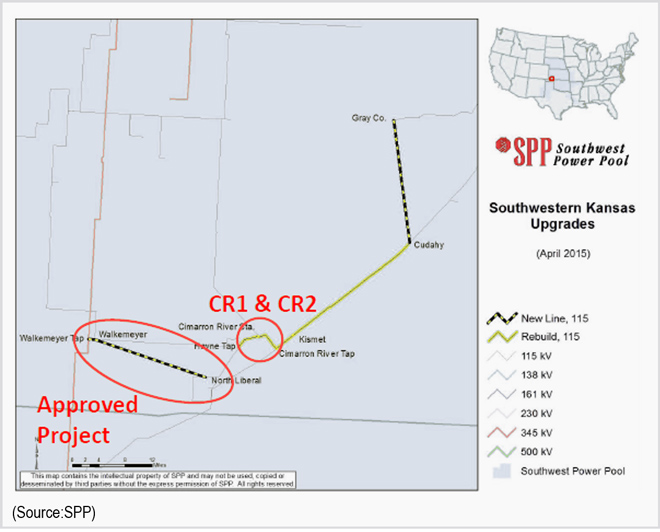By Rich Heidorn Jr.
The SPP Board of Directors approved staff’s recommendation that it authorize construction for a 21-mile 115-kV line from Walkemeyer to North Liberal as part of a reliability solution in southwestern Kansas. The proposal had received almost 64% support from the Markets and Operations Policy Committee in April, falling short of the 66% needed to recommend it to the board.
The board had approved the project in January but asked staff to evaluate an alternative proposed by Sunflower Electric Power that would have delayed the line, instead relying on operating guides for Sunflower’s 76-MW Cimarron River Station to provide relief from thermal or voltage violations.
Staff evaluated three options:
- Option 1 would add a new substation with a 345/115-kV transformer on the Hitchland–Finney 345-kV line and a new 1-mile 115-kV line from the substation to Walkemeyer at an estimated cost of $17.8 million. Cimarron would be dispatched for up to 58 MW when needed to avoid violations.
- Option 2, the staff recommendation, included option 1’s new substation and transformer but would add the Walkemeyer-North Liberal line for an additional $17.5 million, avoiding the need to rely on Cimarron for reliability. Although it had higher upfront costs, staff said option 2 was about $900,000 cheaper than option 1 on a net present value (NPV) basis over 40 years ($68.4 million vs. $67.5 million in 2015 dollars).
- Option 3, which would have relied solely on the Cimarron plant, had an NPV of $78.5 million and only “marginally” solved voltage violations, staff said.
Following the MOPC meeting, staff reevaluated the options using an 8% discount factor, which reduced options 1 and 3 to an NPV of $49 million and $47 million, respectively (2015 $).
Al Tamimi, Sunflower’s vice president of transmission planning, policy and compliance, said the use of the operating guide and a phase shifter could delay the need for the Walkemeyer-North Liberal project until 2030.
Lanny Nickell, vice president for engineering, said staff’s recommendation was driven largely by the age and the slow response time of the Cimarron plant, which includes a 61-MW gas unit built in 1963 and a simple-cycle 15.5-MW combustion turbine added in 1967.
Although Sunflower has projected operation until 2030, “we don’t know how long this [plant] is going to last,” Nickell said.
In addition, he said the larger, 52-year-old unit requires a 30-hour startup time. “If we’re wrong — if we estimate demand too low — it’s too late to start that unit” to respond to real-time problems, Nickell said.
He added that Cimarron has averaged six days of forced outages annually during the summer months over the last three years.
Nickell called the Walkemeyer line a “no-regrets” option. “With options 1 and 3 there’s an opportunity for regrets in depending on generators that may not show up,” he said.
Sunflower disagreed. “Sunflower staff believes that SPP’s ‘no-regret’ solution contradicts its concerns with compliance with the newly effective TPL-001-4 reliability standard, and the use of Cimarron River Station to meet that standard contradicts SPP’s recommendation to include Phase II in the [Integrated Transmission Plan 10-Year Assessment] instead of the ITP [Near-Term Assessment],” the company said in a statement.
The reliability standard, which the Federal Energy Regulatory Commission approved in October 2013, allows transmission planners to plan for “non-consequential” load loss following a single contingency. (See FERC OKs Rules for “Non-Consequential” Load Loss.)




